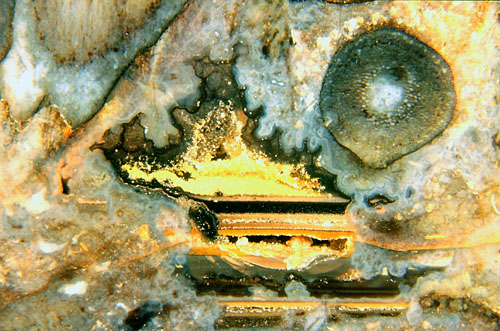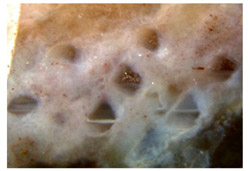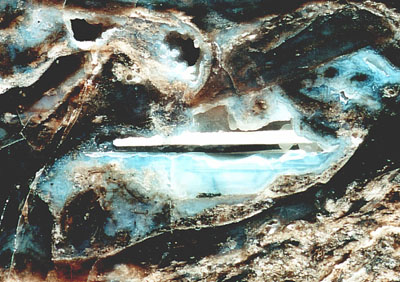Horizontal layers and plates in chert
Agates with horizontal chalcedony layers, among collectors well known
as Uruguay bands or onyx, have been fascinating but controversial.
Formations of this type are found in cherts, too (Fig1). They are
abundant in the Lower Devonian cherts from Rhynie, Scotland, but less
so in other cherts. They have repeatedly led to the idea of a formation
process by silica deposition in a cavity with varying water levels.
Despite of contrary evidence, that seemingly plausible idea is still
widespread. Refuting that idea is so simple that one wonders why it is
still found in recent scientific publications, as in [1,2], for
example.

Fig.1: Stack of coloured layers in a cavity in Rhynie chert,
among them empty ones partially filled with quartz crystals;
rhizome cross-section with rhizoids below indicating the down
direction.
Photograph by J.
Gardavsky .

Fig.2: Cross-sections of tiny conifer needles
arranged in spiral rows on a twig hidden in the depth, 0.5mm across,
hollow before silicification; horizontal bands in the chalcedony fill
serving as evidence against the presence of a water surface during
their formation; first find of needles in
Lower Permian chert from Döhlen Basin, Germany.
If a water surface had been involved, the bands would not go straight
through but turn upwards at either end to form a curve known as a
meniscus. Especially telling are bands in very small cavities. If a
mm-size cavity with wettable walls were half filled with water, the air
would be forced by the water into a spherical bubble so that there were
no plane water level but a spherical surface. As even the smallest
horizontal bands in chalcedony are exactly straight (Fig.2), it must
be concluded that the bands were not formed at a liquid surface. The
fact that a tiny volume of air in water is shaped as a bubble is due to
the dominance of surface tension over gravity at small scales. This has
been ignored in [2] where the effect of gravity on silica sedimentation
within plant cells is considered while the much stronger
effect of surface tension is not.
Dissolved silica or silicic acid is known to form molecular clusters of
various size. The clusters can become so large that they settle and
form a rather well defined horizontal boundary. Bonding between the
clusters eventually turns the emulsion or slurry into gel, and
crystallization may turn the gel into chalcedony. This process can be
modified by the presence of small amounts of other minerals which also
provide colour, and by changing parameters as temperature, pH-value,
etc., and thus it may proceed at differential rates under varying
conditions, resulting in bands of various aspect and microstructure as
it is well known from agate bands and seen in Fig.1.
 Fig.3:
Horizontal chalcedony plate suspended in a cavity in Rhynie chert,
serving as evidence for the dissolution of layers below.
Fig.3:
Horizontal chalcedony plate suspended in a cavity in Rhynie chert,
serving as evidence for the dissolution of layers below.
Photograph by
J. Gardavsky.
The
changing conditions can even reverse some stage of the process so
that a deposited layer may eventually dissolve. If the dissolving layer
is not the uppermost one, a gap arises in the stack of agate bands
which may never close again. Gaps of such origin are not rare in the
Rhynie chert. They make an easy explanation for the thin horizontal
plates occasionally found suspended in cavities in the chert (Fig.3).
Note that one need not concoct scenarios involving liquid flow for
substance transport into and out of the cavities, as often done in
attempts to explain agate formation. Transport of silica by diffusion
through liquid, gel, or along grain boundaries of crystalline phases
would do.
H.-J. Weiss
2007
[1] J.L.
Holloway : Sedimentation in
vesicles: Interpretation of geopetal fabrics in amygdaloidal agates,
The Geological
Society of America, 54. Annual Meeting (March 2005).
[2] A.
Channing, D. Edwards : Experimental taphonomy:
silicification of plants in Yellowstone hot spring environments,
Trans.
Roy Soc. Edinburgh, Earth Sciences 94(2004 for 2003), 503-521.
 |
 |
20 |




 Fig.3:
Horizontal chalcedony plate suspended in a cavity in Rhynie chert,
serving as evidence for the dissolution of layers below.
Fig.3:
Horizontal chalcedony plate suspended in a cavity in Rhynie chert,
serving as evidence for the dissolution of layers below. 
